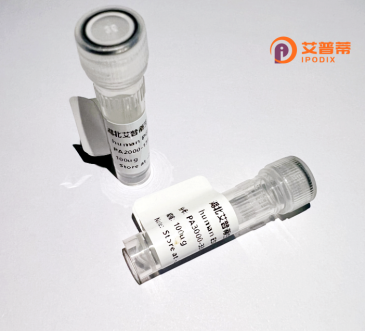
| 纯度 | >90%SDS-PAGE. |
| 种属 | Human |
| 靶点 | RNF168 |
| Uniprot No | Q8IYW5 |
| 内毒素 | < 0.01EU/μg |
| 表达宿主 | E.coli |
| 表达区间 | 1-571aa |
| 氨基酸序列 | MALPKDAIPSLSECQCGICMEILVEPVTLPCNHTLCKPCFQSTVEKASLCCPFCRRRVSSWTRYHTRRNSLVNVELWTIIQKHYPRECKLRASGQESEEVADDYQPVRLLSKPGELRREYEEEISKVAAERRASEEEENKASEEYIQRLLAEEEEEEKRQAEKRRRAMEEQLKSDEELARKLSIDINNFCEGSISASPLNSRKSDPVTPKSEKKSKNKQRNTGDIQKYLTPKSQFGSASHSEAVQEVRKDSVSKDIDSSDRKSPTGQDTEIEDMPTLSPQISLGVGEQGADSSIESPMPWLCACGAEWYHEGNVKTRPSNHGKELCVLSHERPKTRVPYSKETAVMPCGRTESGCAPTSGVTQTNGNNTGETENEESCLLISKEISKRKNQESSFEAVKDPCFSAKRRKVSPESSPDQEETEINFTQKLIDLEHLLFERHKQEEQDRLLALQLQKEVDKEQMVPNRQKGSPDEYHLRATSSPPDKVLNGQRKNPKDGNFKRQTHTKHPTPERGSRDKNRQVSLKMQLKQSVNRRKMPNSTRDHCKVSKSAHSLQPSISQKSVFQMFQRCTK |
| 预测分子量 | 66.6 kDa |
| 蛋白标签 | His tag N-Terminus |
| 缓冲液 | PBS, pH7.4, containing 0.01% SKL, 1mM DTT, 5% Trehalose and Proclin300. |
| 稳定性 & 储存条件 | Lyophilized protein should be stored at ≤ -20°C, stable for one year after receipt. Reconstituted protein solution can be stored at 2-8°C for 2-7 days. Aliquots of reconstituted samples are stable at ≤ -20°C for 3 months. |
| 复溶 | Always centrifuge tubes before opening.Do not mix by vortex or pipetting. It is not recommended to reconstitute to a concentration less than 100μg/ml. Dissolve the lyophilized protein in distilled water. Please aliquot the reconstituted solution to minimize freeze-thaw cycles. |
以下是关于RNF168重组蛋白的3篇参考文献及其摘要内容:
---
1. **文献名称**: *RNF168 binds and amplifies ubiquitin conjugates on damaged chromosomes to allow accumulation of repair proteins*
**作者**: Doil, C., et al.
**摘要**: 该研究通过重组RNF168蛋白实验,揭示了其在DNA损伤位点通过识别并结合泛素化标记(如H2A型泛素链),进一步扩增泛素信号,从而招募53BP1等修复蛋白,促进DNA双链断裂修复的分子机制。
---
2. **文献名称**: *Structural basis of histone H2A lysine 13 ubiquitination by RNF168*
**作者**: Mattiroli, F., et al.
**摘要**: 作者利用重组表达纯化的RNF168蛋白进行结构生物学研究,阐明了其通过UAD结构域特异性识别H2A K13泛素化位点的分子机制,并揭示了RNF168在DNA损伤应答中催化组蛋白泛素化以招募下游因子的关键作用。
---
3. **文献名称**: *RNF168 cooperates with RNF8 to mediate FOXK1 ubiquitination and regulates cell proliferation*
**作者**: Hu, Q., et al.
**摘要**: 本研究通过体外重组蛋白互作实验,证明RNF168与RNF8协同催化转录因子FOXK1的泛素化修饰,进而调控细胞周期进程与增殖,扩展了RNF168在非DNA损伤相关通路中的功能认知。
---
如需更多文献或特定研究方向,可进一步补充关键词优化检索。
RNF168 is a critical E3 ubiquitin ligase involved in the DNA damage response (DDR), particularly in the repair of DNA double-strand breaks (DSBs). Discovered in 2008. it plays a pivotal role in mediating the ubiquitination of histones H2A and H2AX at damage sites, creating docking platforms for downstream repair proteins. Structurally, RNF168 contains a conserved RING domain essential for its E3 ligase activity, as well as two MIU (motif interacting with ubiquitin) domains that enable recognition of ubiquitinated substrates. These features allow RNF168 to amplify ubiquitin signals initiated by another E3 ligase, RNF8. facilitating the recruitment of effector proteins like BRCA1 and 53BP1 to chromatin surrounding DSBs.
The recombinant form of RNF168 is engineered for in vitro and cellular studies to dissect its biochemical functions and interactions. Produced in bacterial or mammalian expression systems, recombinant RNF168 retains enzymatic activity, enabling researchers to study its ubiquitination kinetics, substrate specificity, and binding partners. Its role in DDR has linked RNF168 dysfunction to genomic instability and human diseases. Mutations in RNF168 cause a rare genetic disorder called RIDDLE syndrome, characterized by radiosensitivity, immunodeficiency, and developmental anomalies, underscoring its importance in maintaining genome integrity.
In cancer research, recombinant RNF168 is used to explore DDR pathway vulnerabilities, particularly in BRCA-deficient cancers. Inhibitors targeting RNF168 or its associated pathways could potentially enhance the efficacy of DNA-damaging therapies. Structural studies of recombinant RNF168 have also shed light on its interaction with UBE2N/E2 enzymes and regulatory mechanisms, informing drug design. Overall, RNF168 recombinant protein serves as a vital tool for unraveling DDR mechanisms and developing therapeutic strategies for cancer and genetic disorders linked to DNA repair deficiencies.
×